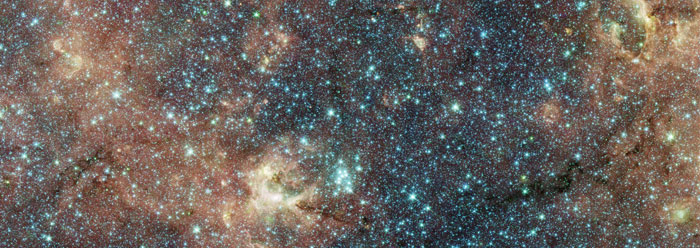There were no human witnesses to the origin of life, and no physical geological evidence of its origin exists. Speaking of the origin of a hypothetical self-replicating molecule and its structure, Pross has recently admitted that "The simple answer is we do not know, and we may never know."1 Later, concerning the question of the origin of such a molecule, Pross said, ". . . one might facetiously rephrase the question as follows: given an effectively unknown reaction mixture, under effectively unknown reaction conditions, reacting to give unknown products by unknown mechanisms, could a particular product with a specific characteristic . . . have been included amongst the reaction products?"2 That pretty well summarizes the extent of the progress evolutionists have made toward establishing a mechanistic, atheistic scenario for the origin of life after more than half a century of physical, chemical, and geological research. It is possible, however, to derive facts that establish beyond doubt that an evolutionary origin of life on this planet would have been impossible. The origin of life could only have resulted from the action of an intelligent agent external to and independent of the natural universe. There is sufficient space here to describe only a few of the insuperable barriers to an evolutionary origin of life.
1. The absence of the required atmosphere.
Our present atmosphere consists of 78% nitrogen (N2), 21% molecular oxygen (O2), and 1% of other gases, such as carbon dioxide CO2), argon (Ar), and water vapor H2O). An atmosphere containing free oxygen would be fatal to all origin of life schemes. While oxygen is necessary for life, free oxygen would oxidize and thus destroy all organic molecules required for the origin of life. Thus, in spite of much evidence that the earth has always had a significant quantity of free oxygen in the atmosphere,3 evolutionists persist in declaring that there was no oxygen in the earth's early atmosphere. However, this would also be fatal to an evolutionary origin of life. If there were no oxygen there would be no protective layer of ozone surrounding the earth. Ozone is produced by radiation from the sun on the oxygen in the atmosphere, converting the diatomic oxygen(O2) we breathe to triatomic oxygen O3), which is ozone. Thus if there were no oxygen there would be no ozone. The deadly destructive ultraviolet light from the sun would pour down on the surface of the earth unimpeded, destroying those organic molecules required for life, reducing them to simple gases, such as nitrogen, carbon dioxide, and water. Thus, evolutionists face an irresolvable dilemma: in the presence of oxygen, life could not evolve; without oxygen, thus no ozone, life could not evolve or exist.
2. All forms of raw energy are destructive.
The energy available on a hypothetical primitive Earth would consist primarily of radiation from the sun, with some energy from electrical discharges (lightning), and minor sources of energy from radioactive decay and heat. The problem for evolution is that the rates of destruction of biological molecules by all sources of raw energy vastly exceed their rates of formation by such energy. The only reason Stanley Miller succeeded in obtaining a small amount of products in his experiment was the fact that he employed a trap to isolate his products from the energy source.4 Here evolutionists face two problems. First, there could be no trap available on a primitive Earth. Second, a trap by itself would be fatal to any evolutionary scenario, for once the products are isolated in the trap, no further evolutionary progress is possible, because no energy is available. In his comments on Miller's experiment, D. E. Hull stated that "These short lives for decomposition in the atmosphere or ocean clearly preclude the possibility of accumulating useful concentrations of organic compounds over eons of time. . . . The physical chemist guided by the proved principles of chemical thermodynamics and kinetics, cannot offer any encouragement to the biochemist, who needs an ocean full of organic compounds to form even lifeless coacervates."5
3. An evolutionary scenario for the origin of life would result in an incredible clutter.
Let us suppose that, as evolutionists suggest, there actually was some way for organic, biologically important molecules to have formed in a significant quantity on a primitive Earth. An indescribable mess would have been the result. In addition to the 20 different amino acids found in proteins today, hundreds of other kinds of amino acids would have been produced. In addition to deoxyribose and ribose, the five-carbon sugars found in DNA and RNA today, a variety of other five-carbon sugars, four-carbon, six-carbon, and seven-carbon sugars would have been produced. In addition to the five purines and pyrimidines found in DNA and RNA today, a great variety of other purines and pyrimidines would exist. Further, of vital significance, the amino acids in proteins today are exclusively left-handed, but all amino acids on the primitive Earth would be 50% left-handed and 50% right-handed. The sugars in DNA and RNA today are exclusively right-handed, but, if they did exist, sugars on a primitive Earth would have been 50% right-handed and 50% left-handed. If just one right-handed amino acid is in a protein, or just one left-handed sugar is found in a DNA or RNA, all biological activity is destroyed. There would be no mechanism available on a primitive Earth to select the correct form. This fact alone destroys evolution. Evolutionists have been wrestling with this dilemma since it was first recognized, and there is no solution in sight. All these many varieties would compete with one another, and a great variety of other organic molecules, including aldehydes, ketones, acids, amines, lipids, carbohydrates, etc. would exist. If evolutionists really claim to simulate plausible primitive Earth conditions, why don't they place their reactants in a big mess like this and irradiate it with ultraviolet light, shock it with electric discharges, or heat it, and see what results? They don't do that because they know there wouldn't be the remotest possibility that anything useful for their evolutionary scenario would result. Rather, they carefully select just the starting materials they want to produce amino acids or sugars or purines or whatever, and, furthermore, they employ implausible experimental conditions that would not exist on a primitive Earth. They then claim in textbooks and journal articles that such and such biological molecules would have been produced in abundant quantities on the early earth.
4. Micromolecules do not spontaneously combine to form macromolecules.
It is said that DNA is the secret of life. DNA is not the secret of life. Life is the secret of DNA. Evolutionists persistently claim that the initial stage in the origin of life was the origin of a self-replicating DNA or RNA molecule. There is no such thing as a self-replicating molecule, and no such molecule could ever exist.The formation of a molecule requires the input of a highly selected type of energy and the steady input of the building blocks required to form it. To produce a protein, the building blocks are amino acids. For DNA and RNA these building blocks are nucleotides, which are composed of purines, pyrimidines, sugars, and phosphoric acid. If amino acids are dissolved in water they do not spontaneously join together to make a protein. That would require an input of energy. If proteins are dissolved in water the chemical bonds between the amino acids slowly break apart, releasing energy (the protein is said to hydrolyze). The same is true of DNA and RNA. To form a protein in a laboratory the chemist, after dissolving the required amino acids in a solvent, adds a chemical that contains high energy bonds (referred to as a peptide reagent). The energy from this chemical is transferred to the amino acids. This provides the necessary energy to form the chemical bonds between the amino acids and releases H and OH to form H2O (water). This only happens in a chemistry laboratory or in the cells of living organisms. It could never have taken place in a primitive ocean or anywhere on a primitive Earth. Who or what would be there to provide a steady input of the appropriate energy? Destructive raw energy would not work. Who or what would be there to provide a steady supply of the appropriate building blocks rather than just junk? In speaking of a self-replicating DNA molecule, evolutionists are reaching for a pie in the sky.
5. DNA could not survive without repair mechanisms.
DNA, as is true of messenger-RNA, transfer-RNA, and ribosomal-RNA, is destroyed by a variety of agents, including ultraviolet light, reactive oxygen species, alkylting agents, and water. A recent article reported that there are 130 known human DNA repair genes and that more will be found. The authors stated that "Genome |DNA| instability caused by the great variety of DNA-damaging agents would be an overwhelming problem for cells and organisms if it were not for DNA repair emphasis mine)."6 Note that even water is one of the agents that damages DNA! If DNA somehow evolved on the earth it would be dissolved in water. Thus water and many chemical agents dissolved in it, along with ultraviolet light would destroy DNA much faster than it could be produced by the wildest imaginary process. If it were not for DNA repair genes, the article effectively states, DNA could not survive even in the protective environment of a cell! How then could DNA survive when subjected to brutal attack by all the chemical and other DNA-damaging agents that would exist on the hypothetical primitive Earth of the evolutionists?
What are the cellular agents that are necessary for DNA repair and survival? DNA genes! Thus, DNA is necessary for the survival of DNA! But it would have been impossible for DNA repair genes to evolve before ordinary DNA evolved and it would have been impossible for ordinary DNA to evolve before DNA repair genes had evolved. Here we see another impossible barrier for evolution. Furthermore, it is ridiculous to imagine that DNA repair genes could have evolved even if a cell existed. DNA genes encode the sequences of the hundreds of amino acids that constitute the proteins that are the actual agents that are involved in DNA repair. The code in the DNA is translated into a messenger RNA (mRNA). The mRNA must then move to and be incorporated into a ribosome (which is made up of three different ribosomal RNAs and 55 different protein molecules). Each amino acid must be coupled to a transfer RNA specific for that amino acid, and the coupling requires a protein enzyme specific for that amino acid and transfer-RNA. Responding to the code on the messenger RNA and utilizing the codes on transfer RNA's, the appropriate amino acids, attached to the transfer RNAs, are attached to the growing protein chain in the order prescribed by the code of the messenger RNA. Many enzymes are required along with appropriate energy. This is only a brief introduction to the incredible complexity of life that is found even in a bacterium.
"Who knoweth not in all these that the hand of the Lord hath wrought this?" (Job 12:9).
Endnotes
- Pross, Addy. 2004. Causation and the origin of life. Metabolism or replication first? Origins of Life and Evolution of the Biospheres 34:308.
- Ibid., 316.
- Davidson, C. F. 1965. Geochemical aspects of atomospheric evolution. Proc. Nat. Acad. Sci. 53:1194; Brinkman, R. T., 1969. Dissociation of water vapor and evolution of oxygen in the terrestrial atmosphere. J. Geophys. Res., 74:5355; Clemmey, H., and N. Badham. 1982. Oxygen in the Precambrian atmosphere; an evaluation of the geological evidence. Geology 10:141; Dimroth, E., and M. M. Kimberley. 1976. Precambrian atmospheric oxygen: evidence in the sedimentary distributions of carbon, sulfur, uranium, and iron. Can. J. Earth Sci., 13:1161.
- Miller, Stanley. 1953. A production of amino acids under possible primitive earth conditions. Science 117:528.
- Hull, D. E. 1960. Thermodynamics and kinetics of spontaneous generation. Nature 186:693.
- Wood, R. D., et al. 2001. Human DNA repair genes. Science 291:1284.
*Dr. Duane Gish is Senior Vice President Emeritus of ICR.
Cite this article: Gish, D. 2007. A Few Reasons an Evolutionary Origin of Life Is Impossible. Acts & Facts. 36 (1).





















